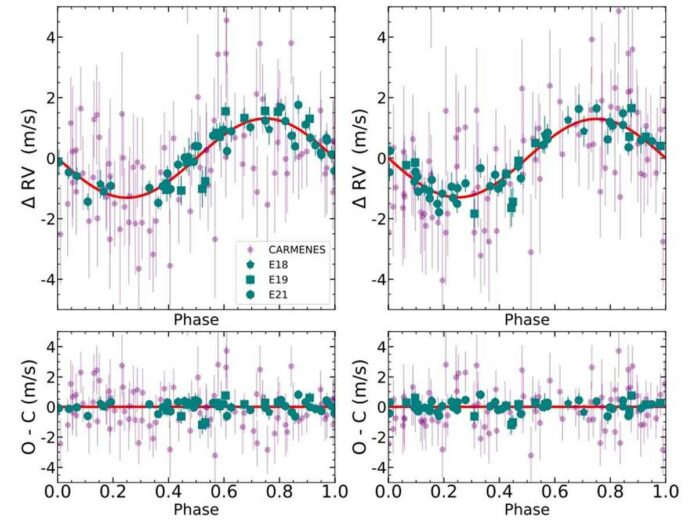An international team of astronomers have discovered two new exoplanets. They were transiting a nearby M-dwarf star known as GJ 1002 using the radial velocity (RV) method. The newly discovered alien worlds have masses comparable to our planet and orbit the host star in its habitable zone. The discovery was published in the journal Astronomy & Astrophysics.
The radial velocity (RV) method for detecting an exoplanet is based on the detection of variations in the velocity of the central star. This variation is caused by the changing direction of an unseen exoplanet’s gravitational pull as it orbits the star. So far, more than 600 exoplanets have been discovered using this technique.
A team of astronomers led by Alejandro Suárez Mascareo of the University of La Laguna in Spain has discovered two new extrasolar planets. Mascareo has discovered them as a result of RV measurements of the M-dwarf GJ 1002. The discovery was made using the Echelle SPectrograph for Rocky Exoplanets and Stable Spectroscopic Observations (ESPRESSO). Mascareo also did the Calar Alto high-resolution search for M-dwarfs with Exoearths using Near-infrared and optical Échelle Spectroscopy (CARMENES).
GJ 1002 b and GJ 1002 c are the names given to the newly discovered exoplanets. They both orbit GJ 1002 within its habitable zone. Because of the star’s proximity to Earth (only 15.78 light years), the planets are among the closest to Earth that could potentially host habitable environments.
GJ 1002 b has a minimum mass of about 1.08 Earth masses. It orbits its parent star at a distance of 0.0457 AU every 10.35 days. The equilibrium temperature of the planet was calculated to be 230.9 K.
GJ 1002 c appears to be slightly more massive than GJ 1002 b. It has a minimum mass of 1.36 Earth masses. The exoplanet is about 0.074 AU away from the host and has an orbital period of 21.2 days. The equilibrium temperature for GJ 1002 c is 181.7 K. According to the astronomers, this alien world could be a good candidate for further atmospheric characterization.
GJ 1002 is a faint M-dwarf with the spectral type M5.5V. It has a radius of roughly 0.137 solar radii and a mass of roughly 0.12 solar masses. The effective temperature of the star is 3,024 K and its metallicity is around -0.25.
The researchers speculated that there could be more Earth-mass planets in the outer half of GJ 1002’s habitable zone.
More information: A. Suárez Mascareño et al, Two temperate Earth-mass planets orbiting the nearby star GJ 1002, Astronomy & Astrophysics (2022). DOI: 10.1051/0004-6361/202244991

